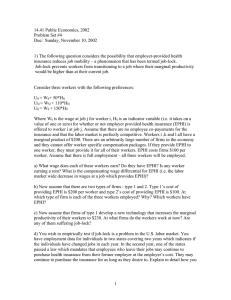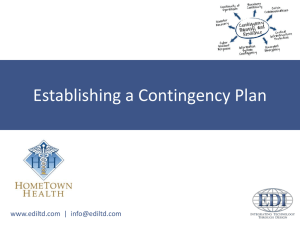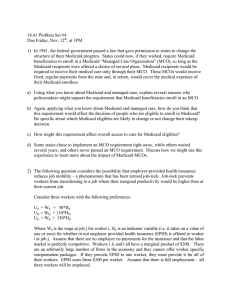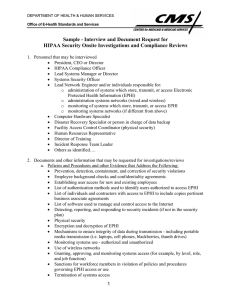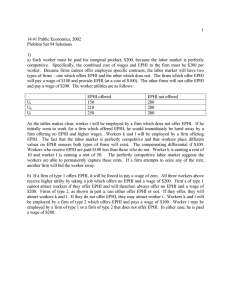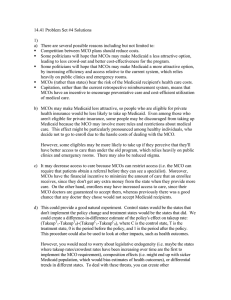Document 11566361
advertisement
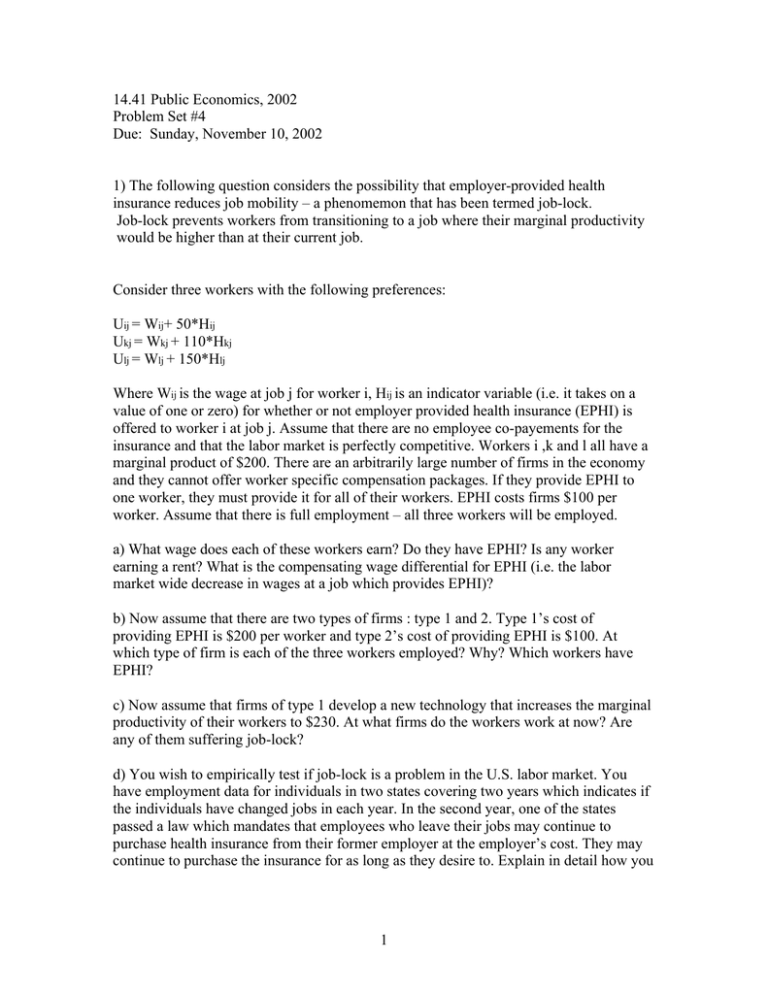
14.41 Public Economics, 2002 Problem Set #4 Due: Sunday, November 10, 2002 1) The following question considers the possibility that employer-provided health insurance reduces job mobility – a phenomemon that has been termed job-lock. Job-lock prevents workers from transitioning to a job where their marginal productivity would be higher than at their current job. Consider three workers with the following preferences: Uij = Wij+ 50*Hij Ukj = Wkj + 110*Hkj Ulj = Wlj + 150*Hlj Where Wij is the wage at job j for worker i, Hij is an indicator variable (i.e. it takes on a value of one or zero) for whether or not employer provided health insurance (EPHI) is offered to worker i at job j. Assume that there are no employee co-payements for the insurance and that the labor market is perfectly competitive. Workers i ,k and l all have a marginal product of $200. There are an arbitrarily large number of firms in the economy and they cannot offer worker specific compensation packages. If they provide EPHI to one worker, they must provide it for all of their workers. EPHI costs firms $100 per worker. Assume that there is full employment – all three workers will be employed. a) What wage does each of these workers earn? Do they have EPHI? Is any worker earning a rent? What is the compensating wage differential for EPHI (i.e. the labor market wide decrease in wages at a job which provides EPHI)? b) Now assume that there are two types of firms : type 1 and 2. Type 1’s cost of providing EPHI is $200 per worker and type 2’s cost of providing EPHI is $100. At which type of firm is each of the three workers employed? Why? Which workers have EPHI? c) Now assume that firms of type 1 develop a new technology that increases the marginal productivity of their workers to $230. At what firms do the workers work at now? Are any of them suffering job-lock? d) You wish to empirically test if job-lock is a problem in the U.S. labor market. You have employment data for individuals in two states covering two years which indicates if the individuals have changed jobs in each year. In the second year, one of the states passed a law which mandates that employees who leave their jobs may continue to purchase health insurance from their former employer at the employer’s cost. They may continue to purchase the insurance for as long as they desire to. Explain in detail how you 1 would test for job-lock. Are there any potential problems with testing for job-lock in the manner you have suggested? 2) This question asks you to use your knowledge about health care economics to evaluate several policy proposals that are aimed at providing prescription drug coverage for the elderly in the United States. Currently, about 56% of Medicare beneficiaries have prescription drug coverage through private employers, private insurance supplements to Medicare, Medicaid, etc. In 1992, the average annual expenditure for prescription drugs was $549; about half of these costs were paid out-of-pocket. a) Explain the pros and cons of government intervention in the market for prescription drug insurance. For each of the following proposals, discuss the likely effects on quantity of drugs purchased (relative to the current system), health care outcomes (again, relative to the current system), and cost-effectiveness of the coverage. Be specific about which Medicare recipients would be most affected by the policies. b) Senator Kennedy proposes full federal coverage for all “medically necessary” prescriptions. c) Senator McCain would allow recipients to opt out of Medicare and, instead, enroll in a private health plan which might include expanded options, such as prescription drug coverage. The government would, presumably, contribute a fixed amount towards the purchases of non- Medicare health plans. Low-income beneficiaries would receive free prescription coverage. The government would pay drug expenses above $6000. d) Senator Daschle proposes that Medicare would offer prescription coverage with a 50% copayment for the first $5000 of spending. For the next $1500, the beneficiary would pay the full costs. After the beneficiary reached a $4000 out-of-pocket spending limit, the government would pay all additional drugs costs. In order to participate in the prescription insurance plan, Medicare beneficiaries would pay a $25 per month premium. Low-income beneficiaries would pay a smaller percentage of their drug costs and premiums. 2 3) Consider a welfare program to ensure that needy people get adequate food. Food stamps are distributed according to the following schedule. For example, people with incomes of $100 get $264 in food stamps. Standard assumptions include the nontransferability of the food stamps. Income 100 200 300 400 500 600 700 800 900 980 Food Stamps Received 264 234 204 174 144 114 84 54 24 0 People have utility functions: ln(ui) = 1/3ln(Fi) + 2/3ln(Xi). Where F is food and X is other goods. The price of food and other goods are both normalized to 1; therefore, the budget constraint is: F + X = Y. a) Consider first the no food stamp world; determine the demands for food and other goods for someone with an income of $300. b) Consider the consumption of food and other goods with the food stamp program in place. Determine the optimal level of consumption of food and other goods, also for someone with an income of $300. c) Show these outcomes with a standard budget constraint/indifference curve graph. d) Does the food stamp program entail a loss or gain in efficiency? If so, then both calculate the value and describe the nature of the loss/gain. e) Repeat a - d for an income of $900, providing intuition for any differences in the outcomes. 3 4) One current government policy to increase the income of the poor is the Earned Income Tax Credit (EITC). Assume that the structure of this credit is as follows: - you receive a tax rebate of 16.7% of wages up to $7140 of earnings - you then receive a subsidy of 16.7% of $7140 up to $11250 - you then are taxed at an extra 11.9% up to $21242 Ignore, for now, the other features of the tax code and of the welfare system. a) Diagram the effect of the EITC on the budget constrain of an individual with a potential wage of $20 per hour b) Will the EITC increase labor supply in the economy? Discuss its possible effects on different groups. c) Now, suppose that there is no EITC, but there is a welfare system that gives a basic grant of $7000 to those with no earnings, but reduces that grant by $2 for every $1 of earnings. Diagram the individual's opportunity set. d) Now, introduce an EITC, as above, into this diagram. What is its effects on the labor supply of different groups now? How does the fact that there is a welfare system change the desirability of the EITC? 4
